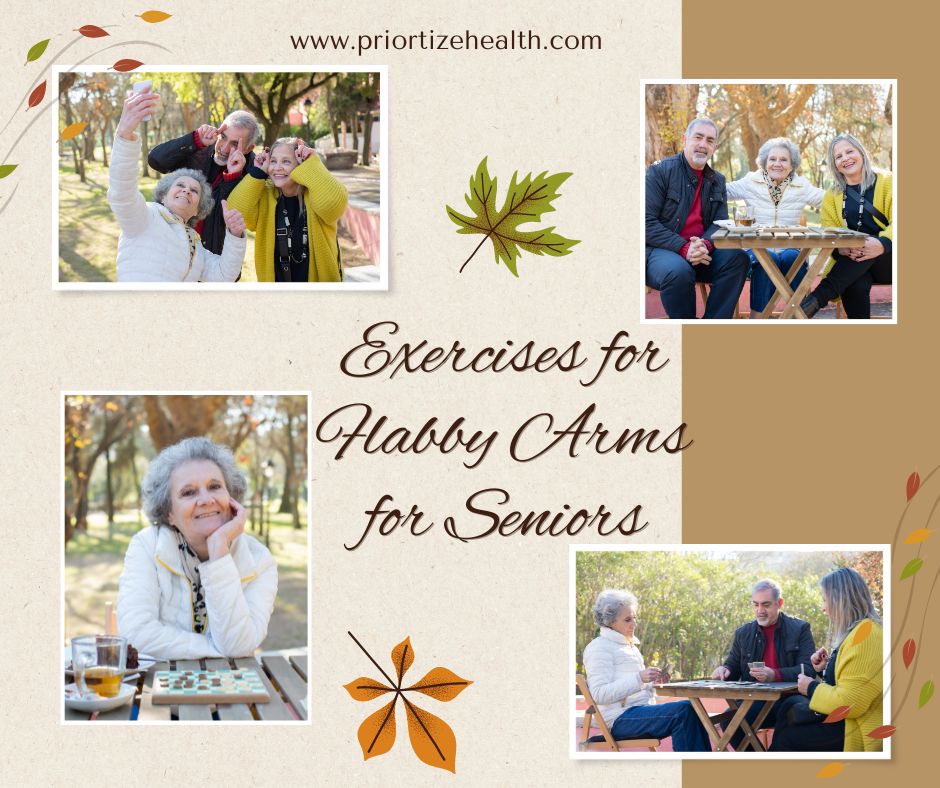
Exercises for Flabby Arms for Seniors
As we age, maintaining physical fitness becomes very important for our health and well-being. One common concern for many seniors is the appearance of flabby arms. It can result from a combination of factors. They are reduction in muscle mass, decreased skin elasticity, and lifestyle changes. It’s normal for the body to undergo changes with age. But, targeted exercises can help tone the arms, improve muscle strength, and enhance mobility. In this blog post, we’ll explore effective exercises. They are beneficial for seniors to tackle flabby arms and support general fitness. Remember to consult with a healthcare provider before starting any new exercise routine. It is necessary if you have any pre-existing health conditions or concerns.
1. Chair Exercises
Chair exercises are ideal for seniors as they provide stability and reduce the risk of falls. These exercises focus on improving arm strength and endurance. They are gentle on the joints.
A) Seated Arm Curls
- Sit on a sturdy chair with your feet flat on the floor.
- Hold a light dumbbell (or a water bottle) in each hand with your arms extended and palms facing up.
- Bend your elbows to lift the weights towards your shoulders. Keep your upper arms stationary.
- Lower the weights back to the starting position.
- Repeat for 10-15 repetitions.
B) Seated Overhead Press
- Sit with your back straight and feet flat on the floor.
- Hold a light dumbbell in each hand at shoulder height, palms facing forward.
- Press the weights overhead until your arms are extended.
- Lower the weights back to shoulder height.
- Repeat for 10-15 repetitions.
2. Resistance Band Exercises
Resistance bands are versatile tools that can add variety to your workout routine. They provide a controlled resistance. It helps strengthen the arms without putting excessive strain on the joints.
A) Resistance Band Bicep Curls
- Sit or stand with your feet shoulder-width apart.
- Place the center of the band under your feet and hold an end in each hand with palms facing up.
- Curl your hands towards your shoulders. Bend your elbows and keeping your upper arms still.
- Return to the starting position.
- Repeat for 10-15 repetitions.
B) Resistance Band Tricep Extensions
- Stand with one foot forward and the other foot back for stability.
- Anchor the band under your front foot and hold the other end in your hand, extending your arm overhead.
- Bend your elbow to lower the band behind your head, then extend your arm to return to the starting position.
- Repeat for 10-15 repetitions on each arm.
3. Bodyweight Exercises
Bodyweight exercises are effective for building strength without the need for equipment. These exercises use your body weight as resistance.
A) Wall Push-Ups
- Stand facing a wall with your feet about hip-width apart.
- Place your hands on the wall at shoulder height and shoulder-width apart.
- Bend your elbows to lean towards the wall, keeping your body in a straight line.
- Push yourself back to the starting position.
- Repeat for 10-15 repetitions.
B) Modified Tricep Dips
- Sit on the edge of a sturdy chair with your hands beside your hips, fingers pointing forward.
- Slide your hips off the edge of the chair and support your weight with your hands.
- Bend your elbows to lower your body slightly, then press back up.
- Repeat for 10-15 repetitions.
4. Low-Impact Cardio
Incorporating low-impact cardio exercises can help with fat loss. They can also improve cardiovascular health, which complements strength training.
A) Arm Circles
- Stand with your feet shoulder-width apart and arms extended to the sides.
- Make small circles with your arms, gradually increasing the size of the circles.
- Continue for 30 seconds in one direction, then switch to the opposite direction.
B) Marching in Place
- Stand with your feet hip-width apart.
- Lift one knee at a time as if marching, and swing your arms for added movement.
- Continue for 2-3 minutes at a comfortable pace.
5. Flexibility and Stretching
Maintaining flexibility is crucial for our mobility. It can enhance the effectiveness of strength exercises.
A) Tricep Stretch
- Raise one arm overhead and bend the elbow, reaching your hand down your back.
- Use your other hand to press the bent elbow.
- Hold the stretch for 15-30 seconds, then switch arms.
B) Bicep Stretch
- Extend one arm straight out in front of you, palm facing up.
- Use your other hand to press down on the fingers of the extended arm.
- Hold for 15-30 seconds, then switch arms.
Arm exercises for seniors without weights
As we age, maintaining physical health becomes vital. For seniors, arm exercises are a key component of a balanced fitness regimen. Engaging in arm exercises without weights is particularly beneficial. It is due to their accessibility, safety, and effectiveness. The following are the reasons for which these exercises are crucial for seniors:
1. Enhancing Muscle Strength and Endurance
Muscle Preservation: Aging in a natural manner leads to a decrease in muscle mass and strength. This condition is sarcopenia. Arm exercises help counteract this loss by maintaining and building muscle strength. This is essential for performing daily tasks. They can be lifting groceries or carrying a bag.
Endurance Improvement: Regular arm exercises improve muscular endurance. It allows seniors to perform everyday activities in comfortable manner. They can perform for longer periods without fatigue.
2. Supporting Joint Health and Flexibility
Joint Mobility: Many seniors experience joint stiffness or discomfort. Arm exercises should focus on gentle, controlled movements. This can improve joint flexibility and range of motion. It makes activities such as reaching overhead or opening jars easier.
Reduced Risk of Injury: Strengthening the muscles around the joints helps stabilize them. It reduces the risk of falls and injuries that can result from weak or unstable joints.
3. Promoting Cardiovascular Health
Boosting Circulation: Arm exercises without weights may not provide the same cardiovascular benefits as more intense activities. But they still contribute to our cardiovascular health by improving blood flow and circulation.
Enhanced Physical Activity: Regular exercise includes arm workouts. It can encourage seniors to stay active and integrate more physical activity into their daily routine. This supports heart health and our well-being.
4. Improving Balance and Coordination
Core Stability: Many arm exercises engage the core muscles. Its play a crucial role in maintaining balance and stability. This is particularly important for preventing falls, a common concern among seniors.
Coordination Enhancement: Exercises that involve arm movements. It can help improve hand-eye coordination and fine motor skills. They are beneficial for performing everyday tasks and maintaining independence.
5. Boosting Mental Health and Cognitive Function
Mental Well-Being: Engaging in regular physical activity, includes arm exercises. They help in reducing symptoms of anxiety and depression. It provides the sense of accomplishment and improved self-esteem. Staying active can enhance mental health.
Cognitive Benefits: Exercise stimulates brain function and can improve cognitive performance. Keeping the body active helps maintain mental sharpness. It may contribute to a reduced risk of cognitive decline.
6. Accessibility and Safety
No Equipment Needed: Arm exercises without weights need minimal or no equipment. It makes them accessible for seniors who may not have access to a gym or prefer to exercise at home.
Lower Risk of Injury: These exercises involve controlled movements and low impact. It reduces the risk of injury compared to high-impact or heavy-weight exercises. This makes them suitable for individuals with arthritis or other joint concerns.
7. Encouraging Consistency and Adherence
Ease of Integration: We can incorporate exercises without weights into a daily routine. The other option is to perform them in a variety of settings. It includes at home or while sitting in a chair. This flexibility encourages regular participation.
Reduced Barriers: The simplicity and minimal need of equipment or space lower barriers to exercise. This makes it easier for seniors to stay motivated and consistent with their fitness routine.
Tips for Success
- Warm Up: Always start with a gentle warm-up, such as marching in place or light arm swings. It helps to prepare your muscles and joints for exercise.
- Maintain Proper Form: Focus on proper form to avoid injury and maximize the effectiveness of the exercises. Keep movements controlled and steady.
- Start Slow: Begin with a few repetitions. Increase them as your strength and endurance improve.
- Stay Consistent: Aim to perform these exercises 2-3 times per week. They will show gradual improvements in arm strength and muscle tone.
- Listen to Your Body: If you experience any discomfort or pain, stop performing the exercises. Consult a healthcare professional.
Final Thoughts
Consistency is key when it comes to improving muscle tone and fitness. Incorporate these exercises into your weekly routine. Aim for at least two to three sessions per week. Alongside your exercise regimen, maintain a balanced diet and stay hydrated. Take adequate rest to support your fitness goals. Remember, it’s always best to start in a slow and gradual manner. Increase the intensity as your strength and confidence improve. With dedication and patience, you can address flabby arms and enhance your physical health. Stay active, stay healthy, and embrace the journey to a stronger, more confident you!
FAQ’s:
Ans. Seniors can tone flabby arms by combining strength training with cardiovascular exercise. Focus on exercises like tricep dips, arm curls, and push-ups. Incorporate regular walking or cycling to boost your fitness. Also, maintaining a balanced diet and staying hydrated supports muscle health. Always consult a healthcare provider before starting any new exercise routine.
Ans. Firming up flabby arms takes 4 to 8 weeks with consistent effort. We should perform strength training exercises, like tricep dips and bicep curls, 2-3 times per week. Combining this with cardio and a balanced diet enhances results. Individual progress may vary based on factors like age, fitness level, and overall health.
Ans. For toned arms at 70, focus on gentle strength training. They are light dumbbell exercises, resistance bands, and chair exercises. Incorporate activities like water aerobics or walking for fitness. Aim for 2-3 sessions per week, and prioritize proper form and gradual progression. A balanced diet and staying hydrated support muscle health and recovery. Always consult a healthcare provider before starting.





